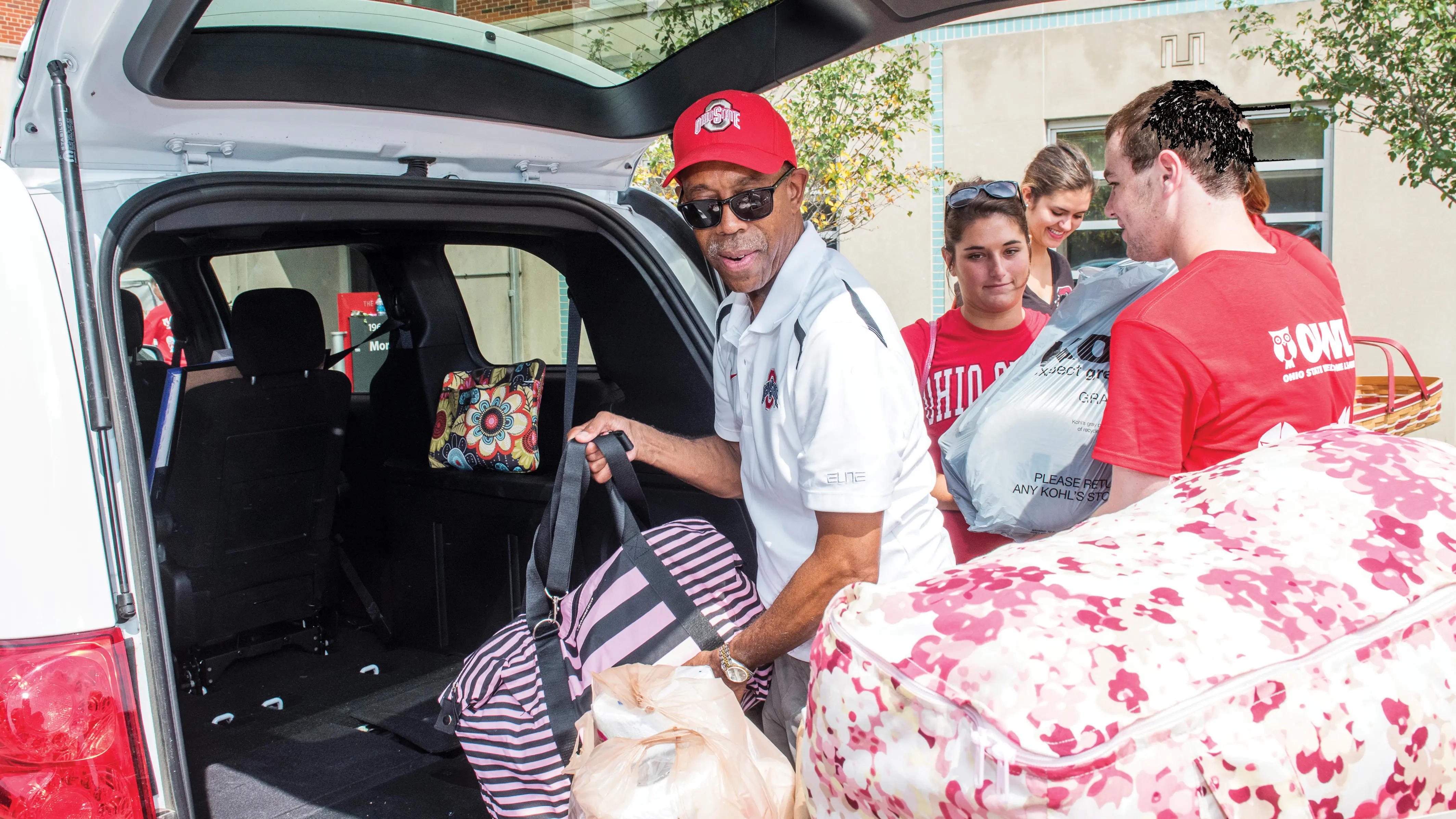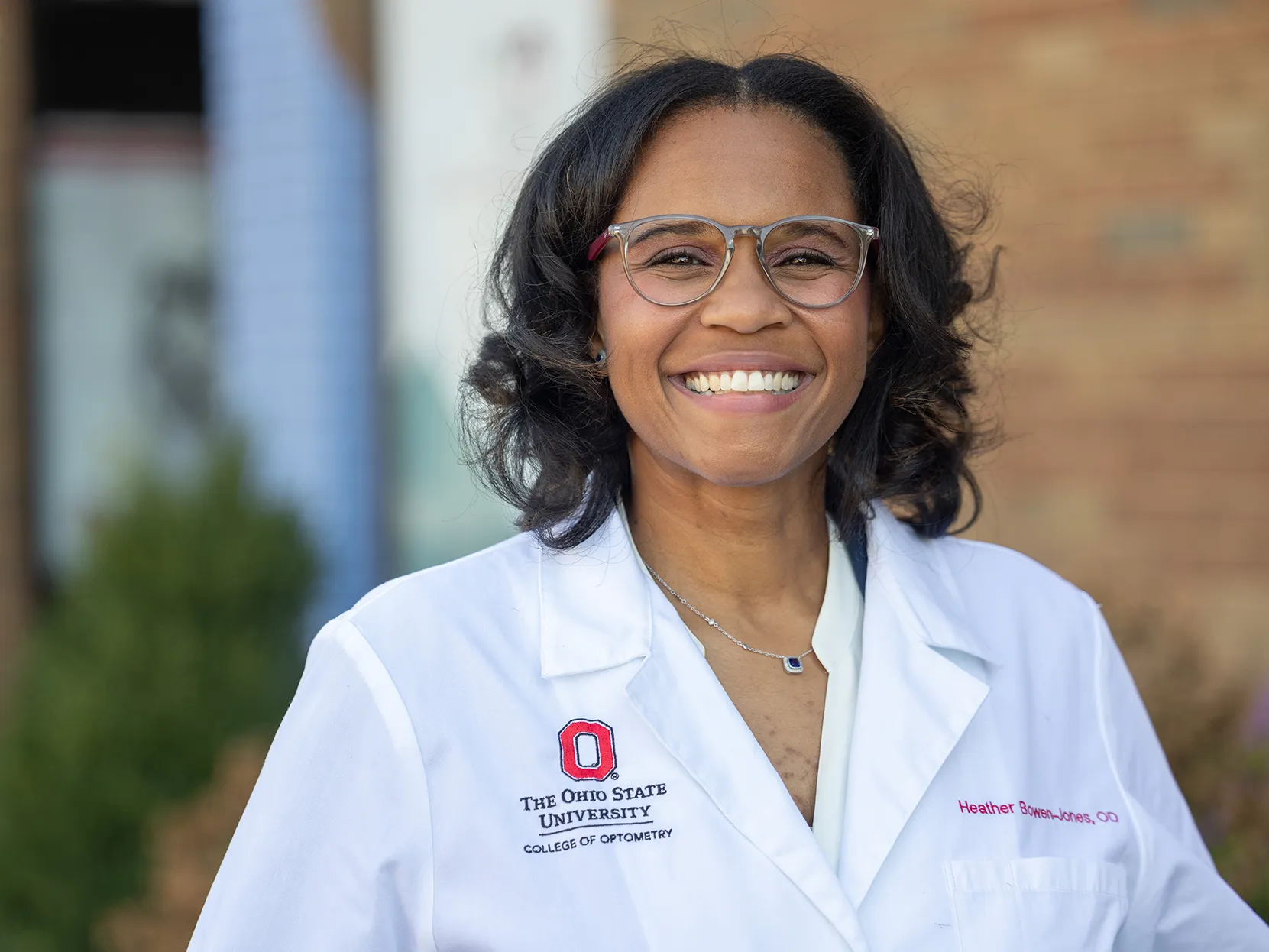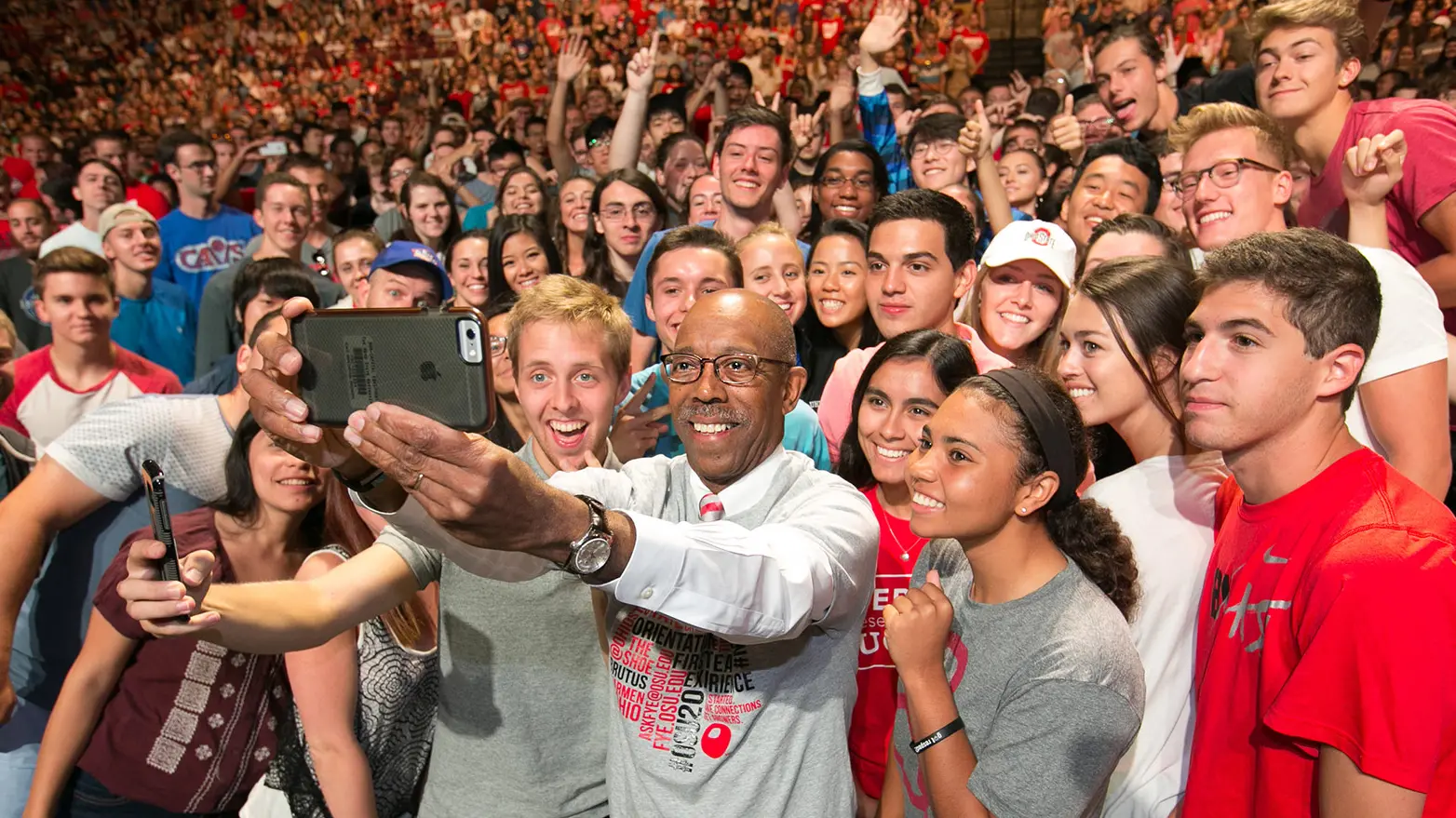

A lasting portrait of progress
As President Michael V. Drake prepares to transition from the presidency of Ohio State, we reflect on our community’s momentum under his leadership.
Visit President Michael V. Drake’s office in Bricker Hall and you’ll see walls and bookcases teeming with photographs of smiling students, distinguished scholars, athletic heroes and community legends. You’ll find keepsakes from Drake’s many trips across Buckeye Nation —from ice cream parlors and a football factory to civic gardens, museums and farms —along with books and footballs signed by authors, players and coaches. All are precious to him. But look closer and you’ll find the foundational inspiration for his life’s work.Behind Drake’s desk is a framed program from his mother’s 1933 graduation from East High School in Youngstown, Ohio.
Beatrice Hayes Drake was one of few African American women to attend college at the time, earning her way to Baltimore’s Morgan State University by working at the local YWCA for a dollar a day. Her degree led to a career as a teacher and social worker.
“My mother was an inspiration to us all,” Drake says. “She was very dedicated, very hardworking, and she pushed us all. She was intolerant of less than a maximum effort.” Across the office is a photo of the 1933 Morgan State football team, which won the Colored Intercollegiate Athletic Association Championship. Drake’s father, Carl, was captain of the team. He went onto Meharry Medical College in Nashville and practiced in the field of psychiatry until his death in 2013 at age 99.
“My father was an avid athlete, and he worked at keeping his mind active. Every day, he cycled, swam or walked with my mother and then, after her death, by himself,” Drake says. “He kept a chess board out and played with the young men and women who stopped by to visit.” Those family values —of dedication, focus and grit —took an early hold on Drake, the third of four children. An outstanding student, he was his high school’s first African American student body president. He went on to Stanford University for a bachelor’s degree in biomedical sciences and African American studies and the University of California San Francisco for his medical degree.
On June 30, 2014, Drake became Ohio State’s 15th president. His career already had included nine years as chancellor of the University of California, Irvine, a public research university where he also was a Distinguished Professor of Ophthalmology and Education. Before that, he served five years as vice president for health affairs for the University of California system and more than 20 years on the UC San Francisco School of Medicine faculty.
Joining Drake at Ohio State was his wife of 45 years, Brenda, a lawyer and foundation executive involved in education, the arts, international health, civil rights and finance. Brenda Drake became a university ambassador, actively engaging in events and initiatives on behalf of the university at the local, regional and national levels. As a team, they brought an unwavering commitment to academic excellence, diversity and opportunity.
When, in the coming months, Michael Drake moves from the role of president to that of a faculty member, he will have spent six years broadening access, enhancing affordability and fostering excellence at The Ohio State University.
Video: A lasting portrait of progress
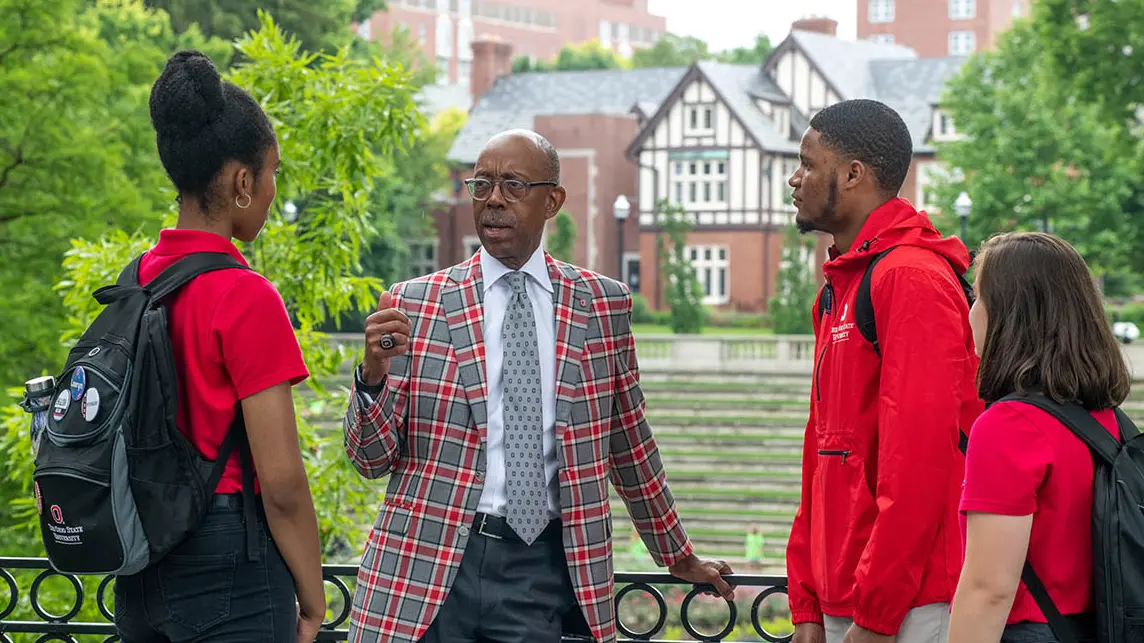
In this video, President Michael V. Drake talks about his pride in the power that Ohio State has to make a difference in the lives of Ohioans. Run time is 1 minute, 40 seconds.
Long before he arrived at Ohio State, Drake developed a deep appreciation for public universities’ ability to empower individuals and communities. College is an engine of economic prosperity, one Drake believes must hum for all people. In his first State of the University address in 2014, Drake reflected on the power of the Morrill Land Grant Act of 1862, which set the stage for land-grant universities such as Ohio State.
“For those of us who have been in higher education for many years, the inspiration behind the Morrill Land Grant Act of 1862 speaks to our highest calling,” he told his audience. “When our university was founded in 1870 as the Ohio Agricultural and Mechanical College, our land-grant purpose was to bring a college degree within the reach of all people, including the sons and daughters of the farmers and working people —the backbone of our society.”
The challenge moving forward, he said, would be to provide an affordable, excellent education to all. Drake immediately set to work.
Under his leadership, Ohio State has greatly expanded financial aid to low-and moderate-income students, committing $200 million in additional funds for need-based support. In 2015, trustees took his recommendation to enact the university’s first comprehensive in-state tuition freeze in more than 40 years. The university launched the Ohio State Tuition Guarantee, ensuring Ohio students would pay the same for tuition, mandatory fees, and campus housing and dining in their fourth year as they did in their first. He supported work to eliminate 70% of course fees and offer steeply discounted digital textbooks. To support initiatives across the university, he oversaw implementation of more than $200 million in administrative efficiencies and $1 billion in funding from sources not typical within higher education.
Recognizing Ohio State’s regional campuses as doorways of access for many students, Drake expanded assistance to thousands of students on those five campuses, a move he says “will help ensure even more Ohio families have the opportunity to advance their lives and communities through higher education.”
More than 40,000 Buckeyes and their families have benefited from new or expanded affordability programs during Drake’s tenure. Among them is Bella Garcia, who will become her family’s first college graduate because of an expansion of the Land Grant Opportunity Scholarship. A third-year business major from Mentor, Ohio, Garcia is the daughter of a single mom who heads a modest household. She graduated from West Geauga High School with a 4.2 GPA. “Bella’s the smart one,” family members said. “She’s going to go places.”
Ohio State was Garcia’s “dream school,” and she applied in hopes of earning a scholarship. When her acceptance letter arrived, she learned of her Land Grant Opportunity Scholarship, which at the time covered the cost of tuition. Garcia was elated, but she worried about how she would cover room, board, books and fees. Weeks before her freshman year began, she learned the scholarship would pay for her full cost of attendance.
“President Drake’s decision [to expand the program] was life changing,” Garcia says. “It’s the difference between sitting in class every day and lying in bed every night worrying about how to
come up with the money to pay for books and room and board. I can actually focus on my classes because I don’t have to work multiple jobs.”
Now in her third year, Garcia is using her experience to mentor other first-generation students at Ohio State. She also serves as a resident advisor, helping Torres House residents navigate the academic and social pressures of college. And she’s a role model for her two brothers in middle school.
“I’ve changed the expectations in my household,” Garcia says. “It makes me so happy that at their age, my brothers are actually thinking about college.”
More Ohio first-generation students such as Garcia have found a home at Ohio State because of Drake’s commitment to increasing enrollment of low-to moderate-income in-state students. Since 2015, the university has seen a 19% increase in first-year students who qualify for federal Pell Grants. In addition, enrollment of minority students is up aboutone-third since Drake arrived, now totaling more than 15,000 of Ohio State’s about 68,000 students. This year’s freshman class is the most academically prepared and diverse ever, and the first-year retention rate —tracking students who return for a second year —has consistently been above 94%, far exceeding the national average. Meanwhile, the four-year graduation rate has risen 8.5 percentage points during Drake’s presidency, to 67%, and the six-year graduation rate is nearly 86%. Both are university records.
Clark Kellogg ’96 was among the university trustees who hired Drake and had high hopes the new leader would prioritize access and affordability. As a volunteer with Big Brothers Big Sisters, the Fellowship of Christian Athletes and United Way, Kellogg knows how valuable a quality education is for a young person in need.
“I would give Dr. Drake five stars,” says Kellogg, who also serves on the committee tasked with searching for Drake’s successor. “He has been unwavering and unrelenting in his desire to move the needle, to make sure that need-based aid became a real part of helping all students access an Ohio State education.”
Kellogg applauds Drake’s work to maintain Ohio State’s academic profile while leveling the playing field, sentiments shared by William E. “Brit” Kirwan, Ohio State’s 12th president and chancellor emeritus of the University System of Maryland. Kirwan has witnessed Drake’s leadership at a national level.
“I firmly believe that the challenge of providing a high-quality education for low-and moderate-income students is the civil rights issue of our time,” says Kirwan, who remains involved with Ohio State through the Kirwan Institute for the Study of Race and Ethnicity. “In this day and age, a high-quality education is a virtual necessity in order to have a chance at a successful career and a good quality of life.”
Kirwan and Drake helped launch the American Talent Initiative (ATI), a collaboration among colleges, universities and Bloomberg Philanthropies that is working to increase the number of low-income students at America’s top-performing institutions by 50,000 by 2025. When planning an expansion of ATI’s membership, Kirwan immediately thought of Drake.
“He was so effective in recruiting some of the most prestigious institutions, such as Princeton, Yale, Berkeley and others. His persuasive powers, his intellect, his commitment were just so evident,” Kirwan says. “Bringing Ohio State into ATI was critical to its success, because it meant Michael was involved and also because of what Ohio State represents. Ohio State has outsized influence in the United States because of how prominent the institution is and its enormous base of alumni, very successful alumni.”
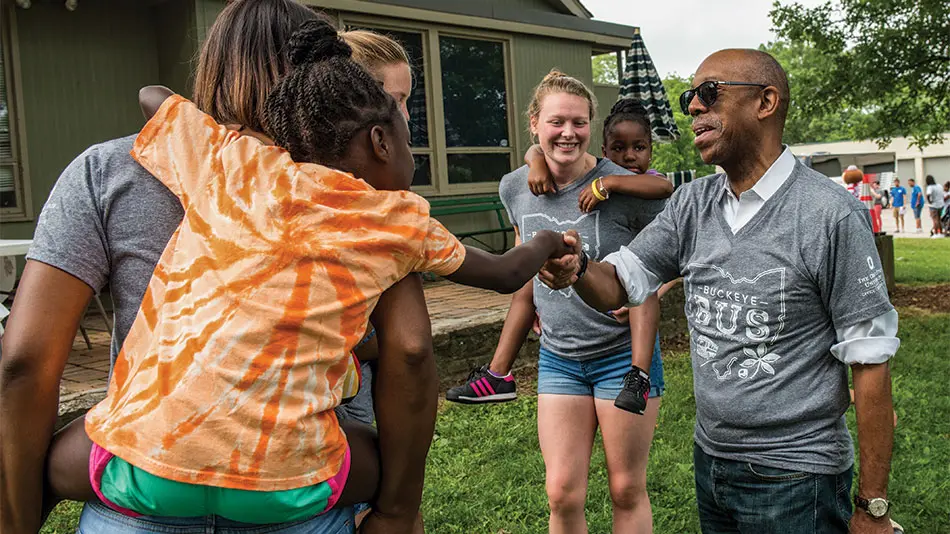
Drake’s annual summer tours of the state often gave him the opportunity to interact with Ohio families. “The great privilege we have at this university is to try to make the future better for all of us.” (Photo by Jo McCulty ’84, ‘94 MA)
Throughout his career, Drake has consistently emphasized the importance of excellence in teaching and learning. “We can make education more accessible and more affordable,” he says, “but if it’s not outstanding, then it doesn’t have great value. It is through the quality of our teaching that students become A-plus thinkers and really contribute to a global society.”
In 2016, Drake launched the University Institute for Teaching and Learning. Led by Associate Professor of English Kay Halasek, the institute offers evidence-based programs and resources to support instructors, increase student engagement and improve learning outcomes.
“Dr. Drake has been leading a culture change here that is reimagining, reinventing and redesigning teaching and learning,” Halasek says. “He recognizes, through his professional roles as a physician andas a medical educator, just how significant good teaching is.” Halasek heard Drake’s first address to the university community and remembers the aspiration he set forth on behalf of those who teach and mentor.
“Dr. Drake has been very consistent throughout his tenure in articulating that he wants the university to be as highly regarded for world-class teaching and learning as it is for research,” she says.
No matter his role, Drake always has set aside time to teach undergraduates, considering it one of the greatest privileges of his profession.
“Our students are bright, enterprising, optimistic and innovative,” says Drake, who regularly co-teaches a course on civil rights and addresses pre-med students on leadership and values. “They are excited about the future. I love existing in a world where it’s all about the future and what we’re going to do and what the possibilities are.”
Stay up to date on the search
A committee appointed by The Ohio State University Board of Trustees is conducting a national search for the university’s next president. Throughout the search, alumni are encouraged to offer input and nominate candidates for consideration. Visit the website for the latest updates.
Drake’s oversight of the health sciences programs of 15 campuses in the University of California system guided him in leading Ohio State’s medical enterprise during a search to fill the new position of chancellor for health affairs. Wexner Medical Center’s chief clinical officer, Dr. Andrew Thomas ’95 MD, ’00 MBA, says the transition went smoothly, largely because of Drake’s medical acumen, composure and leadership style.
“It’s the first time that we’ve had a physician as the university president,” Thomas notes, “and it has been great to have someone sitting in that chair who understands the complexity of health care.”
Despite 28 years at the medical center, Thomas will tell you that looking into the faces of parents whose child is dying is an experience that does not ease with time. On difficult days, Drake has been present to console families, students and the medical staff.
“There’s no announcement. He comes alone, and he comes to comfort, not just as another physician but as a father and a human being,” Thomas says.
Reflecting on his nearly six years in the role of president, Drake says that it’s been very clear to him that what Ohio State does matters —to students, families, alumni, Ohioans and communities around the globe.
“Everybody knows The Ohio State University and cares about what we are doing,” he says. “This is a very important enterprise, and it is worthy of our very best efforts.”

Brenda and Michael V. Drake are a team always striving for Ohio State wins. (Photo by Kevin Fitzsimons)
Drake’s career in higher education spans four decades, including the past 15 as president or chancellor. The time is right, he says, for him and his family to move in a different direction. The Drakes plan to remain active in the Buckeye family. Beyond teaching, the president will devote time to volunteer efforts as well as to national health care and education policy. Brenda Drake also will remain committed to causes close to her heart. “In addition to Ohio State, my focus has been on the Legal Aid Society of Columbus and on arts organizations,” Brenda Drake says. “We both will continue to be active in the community.”
The couple also want to spend more time with the families of their two grown sons, including four grandchildren ages 4 through 7. “The grandchildren love it when we read them stories,” Drake says, smiling. “When they come to visit, they climb up in our laps and settle down like they were made to fit there.”
The focus Drake has on family is always evident. When his father died in 2013, U.S. Sen. Dianne Feinstein introduced a remembrance of Dr. Carl Drake into the Congressional Record. He lived his life with great dignity and grace, it read, and “leaves the world a better place.”
President Michael V. Drake has had the good fortune to stand on the shoulders of dedicated, hardworking parents. And, in turn, the values they ingrained in him leave Ohio State a better university.

